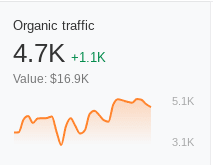Elevate your content with HubSpot Marketing Hub for content marketing. Discover how our strategies and HubSpot's tools drive success.
How We Measure Content Marketing ROI
Your ultimate goal as a content marketer is to attract and educate visitors and engage them in meaningful transactions with your business. But, with so much investment in content production, publication, and promotion, how do you determine if you're driving the benefits (you think) you deserve?
Measuring the ROI of your content marketing efforts is crucial for understanding the effectiveness of your strategies and achieving long-term success. In this guide, we'll tell you exactly how to measure your content marketing ROI to help you optimize content and grow your business.


Why Measure Your Content Marketing ROI?
Measuring the return on investment (ROI) of your content marketing efforts isn't just a recommended practice; it's a critical component for the success and growth of your business.
Content marketing campaigns that are tracked generate 25% more leads than those that are not.
By measuring the return on your content marketing investment, your business can:
-
Demonstrate value: Measuring ROI allows you to quantitatively demonstrate the value your content marketing efforts bring to your organization. It provides concrete evidence of how your strategies contribute to business objectives and justifies the allocation of resources.
-
Improve accountability and decision-making: ROI measurement holds your content marketing accountable for results. It helps you identify what works and what doesn't, enabling informed decision-making and strategic adjustments. By understanding which content generates the highest ROI, you can optimize your efforts and focus on activities that drive the most impact.
-
Optimize resource allocation: Effective ROI measurement enables you to allocate your resources wisely. By identifying which channels, campaigns, or types of content yield the best returns, you can allocate your budget, time, and efforts more efficiently, ensuring maximum impact from your investments.
-
Track benchmarking and improvements: ROI measurement provides a baseline for benchmarking your performance over time. By tracking and analyzing metrics, you can identify trends, patterns, and areas for improvement. It helps you uncover insights into audience preferences, content engagement, and conversion rates, enabling continuous refinement and enhancement of your content marketing strategies.
-
Align with business goals: Measuring ROI ensures your content marketing aligns with your overarching business goals. It enables you to evaluate how effectively your content contributes to lead generation, customer acquisition, brand awareness, and revenue generation. By aligning your content marketing efforts with measurable goals and KPIs, you can optimize your strategies to drive meaningful business outcomes.
By implementing a robust ROI measurement framework, you can unlock valuable insights that drive the success of your content marketing initiatives. But wait–how do you measure content marketing ROI? Let's rewind for a second.
Content Marketing ROI = (Revenue from Content - Cost of Content Marketing) / Cost of Content Marketing.
Revenue from Content = Revenue sourced or influenced/converted by content
Examples: Buyer came through organic search or interacted with web content when visiting the site. You should strive to identify specific content elements (e.g., blog posts) that attracted or converted the contact.
How to get started
Implement Analytics and Conversion Tracking
First things first, you need to implement analytics and conversion tracking. While there are many platforms available, one of the best AND free ones out there is Google Analytics, a tool that works nicely in conjunction with Google Search Console, both providing key insights when looking to improve your Google Search results. To implement Google Analytics, go through the following steps:
-
Go to the Google Analytics website and create an account.
-
Once you have created an account, you will be given a tracking ID.
-
Copy the tracking ID and paste it into the header of your website.
-
Once you have pasted the tracking ID, you must verify your installation.
-
Once your installation has been verified, you can start collecting data.
After successfully installing Google Analytics, the next step is to establish goals that will enable you to track and monitor specific actions and conversions on your website. These actions may include page views, form submissions, and sales.
1. Setting Measurable Goals and KPIs
Setting measurable goals and key performance indicators (KPIs) is the foundation of managing effective content. With clearly defined objectives, it becomes easier to gauge the success and impact of your efforts.
Plus, your goals will guide your content marketing strategy, providing a sense of direction and purpose and enabling you to align your efforts with your organization's objectives. They also serve as a benchmark for measuring success, helping you determine whether you are on track or need to make adjustments.
Here are a few ways in which you can set measurable goals and KPIs:
-
SMART Framework: The SMART framework is valuable for setting measurable goals. SMART stands for Specific, Measurable, Attainable, Relevant, and Time-bound. When setting goals, ensure they meet these criteria. For example, instead of a vague goal like "increase website traffic," a SMART goal would be "increase organic website traffic by 20% within six months."
-
Determine Your Content Marketing Goals: Content marketing goals vary based on business objectives. Common goals include increasing brand awareness, driving website traffic, generating leads, boosting conversions, nurturing customer relationships, or positioning your brand as a thought leader. Defining goals that align with your organization's overall marketing and business strategies is important.
-
Select Relevant KPIs: Key Performance Indicators (KPIs) are quantifiable metrics to measure progress toward your goals. When selecting KPIs, choosing ones that are directly relevant to your objectives is essential. For example, if your goal is to generate leads, KPIs such as lead conversion rate, number of form submissions, or downloads of gated content would be relevant indicators.
Setting measurable goals and KPIs provides a clear roadmap for your content marketing activities. This ensures that your efforts are purposeful, measurable, and aligned with your organization's objectives. With well-defined goals and relevant KPIs, you can track progress, make informed adjustments, and drive tangible results with your content marketing strategy.
2. Tracking and Analyzing Metrics
Once you've established your goals and selected appropriate KPIs, it's crucial to implement systems for tracking and monitoring these metrics. This may involve utilizing web analytics tools, social media analytics, or customer relationship management (CRM) systems. Regularly monitoring your KPIs allows you to stay informed about the performance of your content marketing efforts and make data-driven decisions. Now, let's explore the key metrics to focus on.
-
Website Traffic Metrics: Tracking website traffic is essential for understanding the reach and visibility of your content. Key metrics to monitor include the total number of visitors, unique visitors, and page views. Additionally, analyzing traffic sources (organic search, social media, direct traffic, referrals) provides insights into which channels drive the most visitors to your site.
-
Engagement Metrics: Engagement metrics indicate how well your audience interacts with your content. Important metrics include average time on page, bounce rate, and social shares. A high average time on the page and a low bounce rate signify that your content captures and holds the audience's attention. Social shares indicate that your content resonates with your audience and has the potential for broader reach.
-
Conversion Metrics: Conversion metrics help you assess the effectiveness of your content in driving desired actions from your audience. These actions include form submissions, newsletter sign-ups, downloads, or purchases. You can identify which content or campaigns generate the most valuable leads or customers by tracking conversion metrics.
-
Funnel Metrics: Understanding how your content performs at different stages of the customer journey is crucial. By tracking metrics such as the number of leads generated, lead-to-opportunity conversion rate, or opportunity-to-customer conversion rate, you can assess the impact of your content at each stage of the funnel. This information helps you identify areas for improvement and optimize your content to drive more conversions.
-
Social Media Metrics: If you utilize social media platforms (if you aren't, you should be) for content distribution, tracking social media metrics is essential. Metrics like reach, engagement, follower growth, and click-through rate provide insights into the effectiveness of your social media content and campaigns. They help you understand which platforms and types of content resonate most with your audience.
Consider leveraging tools such as Google Analytics, social media analytics platforms, and marketing automation software to track and analyze metrics effectively. These tools provide in-depth data and reporting capabilities, allowing you to understand your content's performance comprehensively.
The primary way to measure a Google Analytics conversion is to create or identify an event that measures the important user interaction and then mark the event as a conversion. For example, if you use Google Tag or Tag Manager, you would create the event for your website and then go to Google Analytics to mark the event as a conversion.
3. Tools and Techniques for Measurement
Utilizing the right tools and techniques is essential to effectively measure your content marketing efforts' ROI. This section will explore various tools and techniques to help you track and analyze metrics accurately and gain valuable insights into your content's performance.
-
Web Analytics Tools: Web analytics tools like Google Analytics are indispensable for tracking and measuring metrics related to website traffic, user behavior, and conversions. These tools provide detailed data on page views, session duration, traffic sources, and more. They enable you to set up custom tracking, create conversion goals, and generate reports to gain insights into how your content engages and converts visitors.
-
UTM Parameters: UTM parameters are tags added to your URLs that help you track the effectiveness of specific marketing campaigns or content pieces. Adding UTM parameters to your URLs lets you identify the source, medium, and campaign that drive traffic to your website. This allows you to attribute traffic and conversions accurately, providing insights into which campaigns or content types are most effective.
-
Conversion Tracking Pixels: Conversion tracking pixels, such as Facebook Pixel or LinkedIn Insight Tag, allow you to track and measure specific actions visitors take on your websites, such as form submissions or purchases. By implementing these pixels, you can monitor conversions and optimize your content marketing efforts based on customer actions.
-
Event Tracking: Event tracking involves tracking specific user interactions on your website, such as video plays, button clicks, or file downloads. By implementing event tracking, you can gain insights into how users engage with your content and measure the effectiveness of interactive elements.
-
Custom Reporting and Dashboards: Custom reporting and dashboarding tools enable you to create tailored reports and visualizations focusing on the metrics most relevant to your goals and KPIs. Tools like Google Data Studio or Tableau allow you to combine data from multiple sources, visualize trends, and present key insights to stakeholders clearly and concisely.
-
A/B Testing: A/B testing involves comparing two versions of a piece of content or a landing page to determine which performs better regarding conversions or engagement. By conducting A/B tests, you can experiment with different content formats, headlines, CTAs, or designs and measure the impact on key metrics. This technique helps you optimize your content for maximum effectiveness.
By leveraging these tools and techniques, you can ensure accurate tracking and analysis of your content marketing metrics. They provide the necessary data and insights to make data-driven decisions, optimize your content, and maximize the ROI of your content marketing efforts.
You Might Also Like This Post:
4. Interpreting and Acting on Data
Interpreting and acting on the data you gather from your content marketing metrics is crucial for optimizing your strategies and achieving better results. Here's how you can effectively interpret your data and take actionable steps based on the insights you gain.
-
Goal and Benchmark Comparison: Start by comparing your actual metrics against your predefined goals and benchmarks. Analyze the gaps between your current performance and desired outcomes. This comparison helps you identify areas of success and areas that require improvement.
-
Identify Trends and Patterns: Look for trends and patterns in your data. Are specific content topics, formats, or distribution channels consistently performing well? Are there particular periods when engagement is higher? Identifying these trends can help you understand what resonates with your audience and replicate successful strategies.
-
Audience Segmentation: Segment your audience based on different variables such as demographics, interests, or behavior. Analyzing the performance of your content across different segments can provide insights into specific audience preferences and help you tailor your content to serve each segment better.
-
Conversion Funnel Analysis: Dive deep into your conversion funnel to identify improvement areas. Is there a high drop-off rate at a particular stage? Are there content gaps that prevent smooth progression through the funnel? You can optimize your content by pinpointing these issues to enhance the customer journey and drive higher conversions.
-
Iterate and Experiment: Use your data insights to inform iterative improvements and experimentation. Test different content formats, headlines, CTAs, or distribution channels to see which variations yield better results. A data-driven approach allows you to refine your content marketing strategy and drive continuous improvement continually.
-
Collaborate and Share Insights: Share your data insights with relevant stakeholders within your organization. Collaborate with marketing, sales, and product teams to align strategies and leverage cross-functional expertise. By fostering collaboration and sharing insights, you can drive collective decision-making and ensure the integration of data-driven insights across departments.
-
Continuously Monitor and Optimize: Data interpretation and action are ongoing processes. Continuously monitor your metrics, set up alerts or notifications for significant changes, and be proactive in optimizing your content marketing strategies based on real-time data.
By effectively interpreting your data and taking actionable steps, you can optimize your content marketing efforts, enhance audience engagement, and drive better results. Regular data analysis and informed decision-making ensure that your content marketing strategies stay relevant, impactful, and aligned with your business goals.
Leverage ROI to Track The Success of Your Content Marketing Efforts
Content marketing is a long-term strategy, but it can effectively reach your target audience, build relationships, and, content marketing CAN drive sales. If you're patient and persistent, you'll eventually see results.
Additional Financial Benefits of Content Marketing
Traffic value
Many businesses looking for (higher ROI) alternatives to paid traffic from PPC campaigns or paid social media advertising look at the "Traffic value" of their organic traffic.
-
Platforms like Semrush or ahrefs give you the paid traffic value as the estimated monthly cost of paid search traffic from all the keywords a target website/URL ranks for via PPC.
 ahrefs calculates it by multiplying a keyword's monthly paid traffic by the CPC value. Then, the paid traffic cost of individual paid keywords is added up.
ahrefs calculates it by multiplying a keyword's monthly paid traffic by the CPC value. Then, the paid traffic cost of individual paid keywords is added up.
-
Organic Traffic value is the estimated monthly cost of traffic from all keywords a site is ranking for if paid via PPC.
-
Paid Traffic value is the estimated monthly cost of traffic from the keywords a site ranks for via PPC.
Lead indicators
When looking at B2B revenue generation, you want to establish a set of lead indicators to identify the likelihood of achieving your revenue goals. A commonly found set/chain of lead indicators includes the following metrics:
-
Revenue
-
Pipeline size
-
Number of deals initiated
-
Number of SQLs created
-
Website conversions, number of leads
-
Website traffic
-
Number of (Top 3) rankings of targeted keywords
Measuring ROI in content marketing is a dynamic process tailored to each business. Consistent tracking and analysis provide valuable insights to invest wisely, attract eager customers, and optimize strategies. By demonstrating the value and effectiveness of content marketing, you secure support for growth. A data-driven approach empowers informed decision-making, efficient resource allocation, and confident adjustments. Embracing this measurement mindset cultivates a thriving team and fosters engagement with your brand.
This content is also available in:
- German: Wie wir Content Marketing ROI messen
- Spanish: Cómo medimos el ROI del content marketing
- French: Comment nous mesurons le ROI du marketing de contenu
- Italian: Come misuriamo il ROI del marketing dei contenuti
- Romanian: Cum măsurăm ROI-ul marketingului de conținut
- Chinese: 我们如何衡量内容营销的投资回报率









Leave a Comment